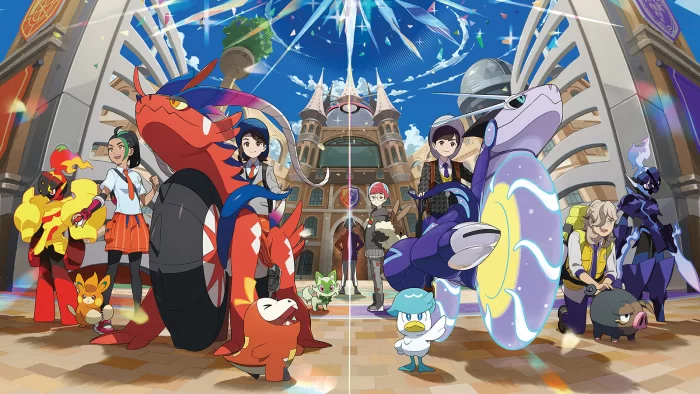What Is/Are Pokémon?
Speaking plainly, Pokémon seems to be less a franchise and more an overt cultural phenomenon. If you don’t believe me, just check out Pikachu Outbreak. It’s an annual event where over 2,000 of the iconic electric mice Pokémon can be found in parades, waterfronts and malls in Yokohama, Japan. In the same way Star Wars has reshaped the landscape for sci-fi storytelling, Pokémon has become something of a rite of passage for nerdom. But it comes in many forms. From manga and anime to video games and trading cards, the series’ reach seems nearly limitless.
Literally speaking, Pokémon is short for “pocket monsters”, which encapsulates the main idea of the entire franchise. In this fantastic world, humans and Pokémon coexist as companions, friends, and even battling partners. Those who raise Pokémon are known as trainers. Their adventures typically start at the age of ten and last a lifetime. For many trainers, the primary goal is to become the reigning Pokémon champion, the strongest trainer in their region. To do this, they must defeat elite trainers known as gym leaders and collect badges. once they have obtained enough badges, they have the opportunity to participate in Pokémon League tournaments, where the strongest is dubbed champion. But the various regional Pokémon Leagues vary in their requirements and tournament formats.
Generations, Regions and Games — Oh My!
Pokémon, as a series, is broken up into different generations and corresponding geographical regions. In a sense, each generation is a reset for the series, introducing new Pokémon, characters and locations. Chronologically, new generations are released about every four years, which allows ample time for development. But the primary reasoning behind the different generational resets seems to be offering a new, fresh take to the up-and-coming youth just starting out. In that sense, each generation corresponds to a new generation of games — hence, the rite of passage. But if my personal experience is anything typical, people tend to play the games over multiple generations. This allows them to find their own personal favorites.
In the main Pokémon timeline, there are currently eight different generations, as described in the chart below.
| Generation | Years | Primary Region | Main Games |
| 1 | 1996-1999 | Kanto | Red & Blue |
| 2 | 1999-2002 | Johto | Gold & Silver |
| 3 | 2002-2006 | Hoenn | Ruby & Sapphire |
| 4 | 2006-2010 | Sinnoh | Diamond & Pearl |
| 5 | 2010-2013 | Unova | Black & White |
| 6 | 2013-2016 | Kalos | X & Y |
| 7 | 2016-2019 | Alola | Sun & Moon |
| 8 | 2019-Present | Galar | Sword & Shield |
Where to Begin Your Journey
Ultimately, there’s no right place to begin when it comes to Pokémon — it’s more a matter of personal preference. There are dozens of different combinations of ways to get started. But the easiest thing to do is pair a generation with a medium and let it go from there. Medium, here, refers to the different forms of media — anima, manga, games, trading cards, and so on. The Pokémon Database can help with choosing a starting generation. It features images of every Pokémon in numerical Pokédex order. And since it can be filtered by generation, you can start to get an idea of which Pokémon you can expect to find in each region, game, or trading card run.
Something worth noting is that subsequent generations typically feature Pokémon from previous generations, though not always. So, for example, you’ll see Charizard in Gen 8 mediums, even though it was one of the first Pokémon ever released — way back in 1996. Also important is the understanding that, if you intend to play Pokémon video games, they’ll require different consoles. Although, some games have been remade for newer generation consoles and systems. The Pokémon website offers a full list of the games, remakes and necessary consoles.
When there are over 800 different Pokémon, multiple regions and mediums, understanding where to start your Pokémon journey can be difficult. But it doesn’t need to be. The Pokémon world is friendly to its fans, giving them multiple ways to enjoy it. But if I had to recommend a starting place, I won’t hesitate to point newcomers to Pokémon Crystal version. Even though it released on Gameboy Color in the U.S. in 2001, it’s still one of the best entries out there. But don’t feel like you have to heed my advice — pick a generation and dive in!

Braden, the creative force behind Scissortail Guild. With a Master’s degree in Fine Arts and over 4 years of experience in the creative industry, Braden has dedicated his career to fostering a vibrant online community. Scissortail Guild connects creators and fans, contributing to the thriving nerd culture of Oklahoma and beyond.
Braden’s expertise spans comics, gaming, cosplay, and more, ensuring high-quality content and tutorials for all enthusiasts.
Stay connected with Braden and Scissortail Guild: Facebook, Instagram, Pinterest and Twitter(X)
